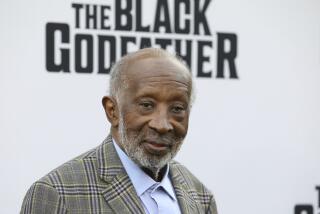Clarence Leo Fender; Created Renowned Stratocaster Guitar
- Share via
FULLERTON — Clarence Leo Fender, the electric guitar pioneer whose renowed Stratocaster models have been revered and played by such rock ‘n’ roll legends as Buddy Holly, Eric Clapton and Jimi Hendrix, died here Thursday, apparently of natural causes.
Fender, 81, was found unconscious in his home by his wife, Phyllis, and died en route to a hospital, police said.
While Fender did not invent the electric guitar, he did revolutionize and perfect it. Called the Henry Ford and the Thomas Edison of the instrument, Fender’s solid-body guitars and amplifiers set the industry standard for excellence.
“Fender was a phenomenon,” said Peter Schuelzky, general manager of the Guitar Center in Hollywood. “He created the guitar (to) which all other manufacturers try to conform. . . . Nobody has been quite as successful.”
Electric guitars made Fender, a tinkerer and inventor by nature, a millionaire.
In 1954, he created the Stratocaster, a revolutionary instrument hailed as a near-perfect fusion of electronics, ergonomics and technology on one side and design and aesthetics on the other.
“The Stratocaster is like the Rolls-Royce,” said Dick Dale, 53, known as “king of the surf guitar” for pioneering the surf rock sound in Orange County in the late 1950s and early ‘60s. “It can never be surpassed.”
Although solid-bodied electric guitars had been around since the 1930s, Fender improved the frets, the tuning pegs and electric pickup. The “Strats” broke musical barriers with their variety in tone. At first it sold as cheaply as $75. Now rare, early models can fetch up to $20,000.
For his work, Fender was inducted into the Country Music Hall of Fame and the Rock Walk of Fame.
But rockers were the ones who made Fender a household name, in and out of the music world. When the Rolling Stones were inducted into the Rock and Roll Hall of Fame, guitarist Keith Richards took his time at the mike to honor Fender: “I’d just like to say, ‘Thank God for Leo Fender, who makes these instruments for us to play.’ ”
Dale was devastated.
“I’m not too good,” he said in a telephone interview from his home in Twentynine Palms. “I just heard the news about a very close friend. . . .”
Dale received one of the first Fender amplifiers after the guitarist’s father approached Fender for help when Dale decided that his pawn-shop amp could not produce the booming sounds necessary to please the large crowds at the old Rendezvous Ballroom on the Balboa Peninsula.
That began a trial-and-error process in which Fender tried to come up with increasingly bigger, more powerful amplifiers that could put out the booming, fat, surf rock sound that Dale wanted. The end result was the Fender Showman amplifier, which became a standard piece of rock music equipment.
“We had a rapport, where he gave everything to me to experiment,” Dale said. “He had a saying--’If it can withstand Dick Dale, it is fit for consumption on the market.’ ”
Born Aug. 10, 1909, on a small farm in Anaheim, Fender first began tinkering with guitars as a radio repairman in the late 1940s. He sold his company--27 buildings in Anaheim and Fullerton--to CBS Inc. in 1965 for $13 million.
Fender never quite retired. Ten years ago, he began working for his newest company, G&L; Musical Products, despite bouts with illness including Parkinson’s disease and recent strokes.
“He was a man whose brain was always trying to improve things,” Dale said. “He’d stay up all night, he’d never go to sleep. He was always trying to make something better. And he did. . . .”
More to Read
The biggest entertainment stories
Get our big stories about Hollywood, film, television, music, arts, culture and more right in your inbox as soon as they publish.
You may occasionally receive promotional content from the Los Angeles Times.











